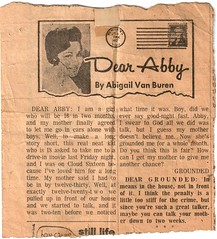
Why your blog’s content must be like a C.P.A.
C.P.A. That’s the three things. Huh? Your accountant? Well…. sort of. What do you want from an accountant? My guess is that you want someone who is:
- Passionate about helping you.
- An authority on their subject.
- Focused on you and your situation.
- Working from a plan; knows how to help you.
- Accessible to you; easy to understand; there when you need them.
Gosh, golly… that’s exactly what your blog readers want from you! So if you’ve got passion and authority (and I certainly hope you have that about your mission and the work of your organization) then you’re already ahead of the game. Woo-hoo! Now you just need to package everything, and make sure you’re Constituent-centered (focused on your readers); Planful (you know what your blog’s goals and objectives are and how you can use your blog to be of value to your constituents), and Accessible (folks can easily connect with you and understand what you’re sharing with them).
Once you understand the principles of C.P.A. you’ll be well on your way towards having a blog with content that knocks the socks off your readers. Today, let’s begin with how to put the ‘C’ in C.P.A.
CONSTITUENT-CENTERED CONTENT
What do I want from you? Pretend I’m your audience. What do I care about? You don’t want to find yourself in the shoes of a baker trying to sell me bread when I’m gluten intolerant. You can have the best sales techniques in the world; I’m never going to buy. And I’m going to get ticked off at you because I think you should know me better than that. Remember: Our mantra in nonprofit marketing/development, courtesy of Penelope Burk’s research into Donor Centered Fundraising, is “Show me that you know me!”
The first time I encounter you I’m not inclined to trust you. So how do you demonstrate to me that you’re not going to waste my time? The key is research. You’ve got to find out what I want.
Here are 6 actionable tips to help you do just that:
1. Brainstorm your constituents’ top problems/Verify with 3rd party sources

Channel your internal ‘Dear Abby.’
Don’t just guess. You’ve got to include people in the room who interact on a regular basis with your constituents. You want folks with real data. The receptionist who takes calls. The database manager who handles donor inquiries or complaints. The box office, admissions office, front desk, program staffer,teacher… you don’t just want the boss’ opinion. Research shows that those with the most power/status are usually those who are furthest away from being perceptive about your constituents’ needs and wants (see To Sell is Human by Daniel Pink; also research by Dacher Keltner at the University of California, Berkeley).
Remember: It’s likely that if one person is asking a question of your staff (or board or volunteers) it’s probable that another hundred other folks have the same question and would appreciate having it answered. Here’s your opportunity! Be helpful. Channel your internal “Dear Abby” and help folks figure out where to look… how to handle the situation… how to act… what to do. They’ll be grateful for your help.
2. Search on Google “[your subject] FAQs” or “Top [your subject] problems” or “Why is/are [your subject] important?”
Get basic with search queries, depending on your industry. Work with battered women? How about “Domestic Violence FAQs”? Work with animals? How about “Abandoned Pets FAQs”? Or get creative and put yourself in the shoes of a prospective donor. How about “Why should I build wells in Africa?” or “Why are the arts important?” or “National vs. local charity?” You’ll be amazed at the riches you’ll find – giving you great insight into your prospective donors’ burning questions.
Check Table of Contents for blog topics
3. Look inside Amazon book Table of Contents; Find information that points to customer problems and unanswered questions.
This is fun! Go to a book that’s about something in your industry (e.g. health care; education; arts; environment). Click on the turned-down page and enter into the Table of Contents. You’ll find plenty of fodder for blog posts here. In this particular book, I had the choice of: “What’s wrong with American schools?; “How to make school a magical place”; “How to raise the bar for everybody”, and more.
4. Read Amazon (or other) book reviews; See what problems reviewers feel books leave unanswered; See what reviewers find helpful and want to learn more about.
The same book revealed to me, in the book review section, that folks were not finding answers as to how to apply what they read to all schools; only to this charter school. Hmmn… could I offer them some answers? I also learned that they found the tips on what to read to your kids very helpful. Hmmn… could I write a blog post on this subject? See how it gets the juices flowing?!
5. Ask folks directly; Consider a survey.
This is the tried-and-true method of market research, made easier-than-ever due to helpful online tools. Choices include services like Qualaroo(paid), Survey Monkey (there’s a free version) and Google Docs (also free, and their You Tube video walks you through the process). You can simply ask a single question: “What questions about [your charity] do you most want answered? Then go to town answering folks on your blog posts!
6. Review “Answers” on LinkedIn Forums or Q & A sites like Yahoo Answers or Quora.
People post questions on all sorts of topics … parenting, elder care, pet care, recycling, safety, legal issues… the list goes on and on. Try to answer folks on forums to establish your credibility as a thought leader in your space. My favorite space is LinkedIn. If you go to the top of your LinkedIn account profile (or the Home Page), you’ll see a list of topic headers. At the far right is “More”. Click on that, and you’ll see a drop-down that has “Answers.” Click on that, and you can browse a ton of different industries and subject areas. Each area will have questions posted to which folks are seeking answers. Endeavor to answer them! Better yet, write a blog post that answers the question; then go in and link you answer to your post. That way you’ll drive folks to your blog/website, and hopefully pick up some new constituents.

Be attuned to constituent questions.
BOTTOM LINE: Become a listening post. Be attuned to every question you’re ever asked – from this day forward. Email. Phone. Face-to-face. Wherever questions come from, pay attention. Jot them down. Find a system that works for you (text into your phone; carry a sticky pad; speak into a mini-recorder). Then… start to answer the questions. Voila! You’re now starting from what your constituents care about ; not from what you care about. You’ve come a long way baby!
Coming up: In Part II we’ll discuss how to put the “P” (aka Plan) into C.P.A. so that your content strategy becomes thoughtful, intentional and consistent. No more winging it, please.
Want to learn more about building a nonprofit blog to drive awareness and support to your nonprofit?
Check out my new E-Course: Charity Blogging Gold. I’ll show you how easy and rewarding blogging can be. If you do nothing else this year, you should get your nonprofit a blog!






I hope you win the blogger of the year award…you’re great at this CPA process. What is the #1 lesson you’ve learned about blogging so far? Can’t wait for part 2!
Aw, shucks. Thanks Natasha. The biggest lesson? I think it’s that it really helps to be passionate about doing it. I love it, so I keep it up. It’s fun. If you’r assigned to blog for your nonprofit, and you don’t enjoy it, perhaps there are others in your organization who would be a better fit. Just like the accountant, your consumer wants you to be passionate!
This is so helpful – I love the combination in your writing of the big picture overview (goals) and the details on how to actually get it done (implementation). And the idea of looking at the table of contents of books on our subject area is BRILLIANT – I got excited and jazzed just thinking about doing that exercise, so I can tell its going to be productive! Thank you Claire! As always, terrific post!
Thanks Julia. I’m so glad you found this helpful. That’s my goal!
THANKS CLAIRE. VERY INSIGHTFUL. I’M A CPA, BUT I NEVER THOUGHT OF MYSELF AS CUSTOMER (CLIENT, CONSTITUENT) CENTERED, PLANFUL AND ACCESIBLE. BUT WHEN I THINK BACK ON MY WORK EXPERIENCE, I GUESS I WAS. NOW I NEED TO COMMUNICATE THAT TO MY CURRENT CONSTITUENTS (CLIENTS, CUSTOMERS)
That’s so cool! Thanks for sharing, and I’m glad to hear you’re all those things. 🙂
Thanks so much, Claire. I’m eager to learn more about how to drive traffic to one’s blog.
It’s my pleasure.
I agree with Julia. I really appreciate/enjoy how you address an overall issue but then get very specific about what people should do. I am excited to see your next installment!
Thanks so much Ericka.
I would say that these ideas are also great for getting feedback from your staff. Find ways to engage them and ask questions. What are they thinking and not telling you? Are their hidden problems that need your attention? Can you provide solutions to frustrations they did not know they had? I am looking forward to part two.
Good observation David. Thanks!